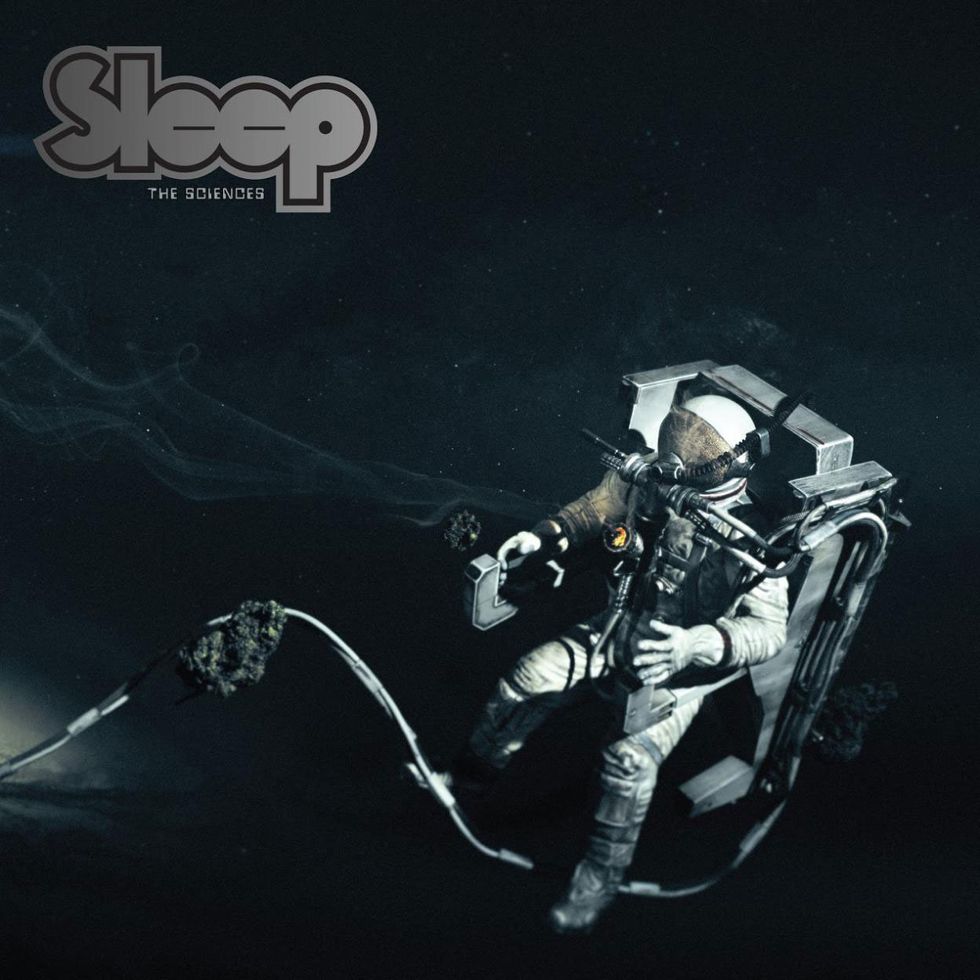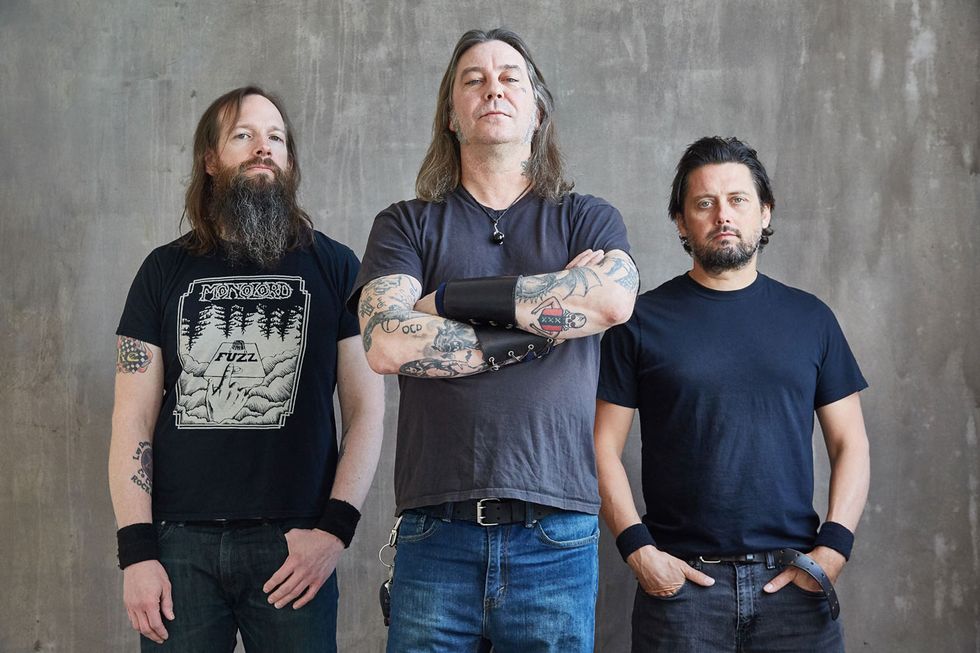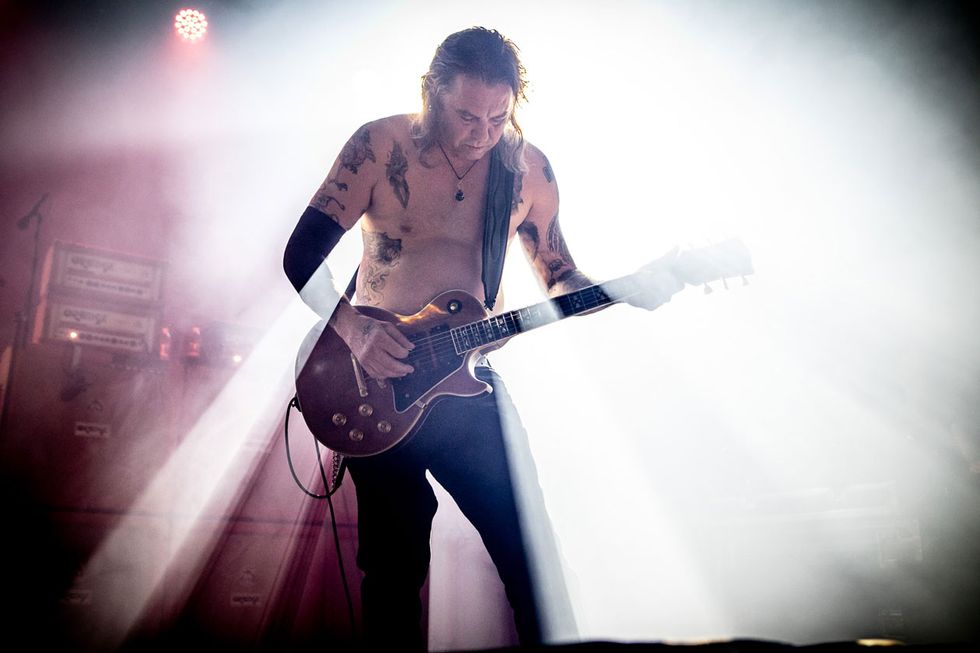Matt Pike is much like his guitar playing—powerful, blunt, slightly pissed off, and occasionally out of tune. And he’s been playing guitar almost as long as he’s been talking. “My uncle and grandpa used to always play guitar and I just remember loving those times,” says Pike. “Ever since I could handle a guitar, I’ve been playing one.”
Pike’s headbanging lineage started in the ’90s with stoner-metal icons Sleep, and after that band’s initial burnout, continued with the ferocious High on Fire. Decades of playing have honed Pike’s perspective about his instrument and music: “Riffs are the conversation starter—that’s what brings people in, but you better have more to offer than just that,” he says. “I create with the guitar and the riff is my illustrative force.” For fans of Pike’s raging riffage, it should be no shock that the frontman/guitarist had enough to say by way of his guitar (and High on Fire lyrics) to populate two new albums: Electric Messiah from High on Fire and Sleep’s The Sciences.
“Honestly, Electric Messiah is an album we could only make after 20 years as a band,” says Pike. It took us the seven other albums to create this strong of material, but that’s a testament to how much pride we have in our work, our story, and our vision.”
Electric Messiah includes the juggernaut “Steps of the Ziggurat/House of Enlil.” Inspired by Zecharia Sitchin’s belief in ancient astronauts, the song clocks in at just under 10 minutes. “It’s my Meatloaf rock opera on the Sumerian creation story,” says Pike.
“I know ... put a tin-foil hat on me because I’m into conspiracy theories. I don’t always believe what I write about, but it’s all based on things that I could perceive as possible. I’m a truth seeker—I want to know.”
If High on Fire has been Pike’s Godzilla for two decades, threatening innocents with bludgeoning albums nearly every three years, Sleep is Pike’s smoldering phoenix. The ’90s power trio garnered a devoted cult following by way of their 1993 riff opus Holy Mountain. Sadly, musical differences and label complications thwarted their triumphant return with 2003’s Dopesmoker, which consisted of one 50-minute song. (The band doesn’t endorse the 1999 Jerusalem release from The Music Cartel.) And so the trio split: Pike started High on Fire, while bassist/vocalist Al Cisneros and drummer Chris Hakius launched Om.
But the split wasn’t permanent: Sleep officially reformed in 2010 with Neurosis drummer Jason Roeder. “When we started playing those first Sleep shows around 2010, we couldn’t fucking believe all the kids that came out,” says Pike. “We hadn’t done dick for 15 years and when we came back to all those fans, we knew the world wanted to hear more.”
Pike’s Sleep and High on Fire are very different bands, but, like a well-loved cast-iron skillet, each have gotten better with seasoning and age. PG conducted two separate interviews with the bare-chested shredder who reveals what makes the guitar a spiritual instrument, how he creates his tones for each band, and why hiccups are necessary for Sleep.
Both your bands released new albums in 2018. Describe in one word your playing discipline in Sleep and High on Fire.
Sleep would be patience, or pacing, and High on Fire would be articulation.
Can you elaborate?
High on Fire is a fancy-picking band, Sleep is a fancy-timing band. Sleep is so difficult to play. I know people would assume the speedier High on Fire stuff is a technical challenge, and it is dexterous for sure, but it’s hard to know when to hit in Sleep. If you don’t match the ‘hit’ points—or ‘hiccups,’ as I call them—you’re off that whole measure, and it can just get worse from there. With High on Fire, there are so many notes that you can hop back on the merry-go-round more seamlessly than with the dredging of Sleep.
One of the greatest musical things I’ve learned through Sleep is the acceptance of space. You don’t have to fill up every single moment with noise. I’d rather wait and drop the bomb at the perfect moment than barrage you into submission—Sleep proves that one well-placed note can say more than 150 perfectly played notes.
And what are “hiccups?”
Hiccups are what Al and I call phrasing and dynamics—when you hit notes in the middle of a measure that weren’t there in the last passage. Those small hiccups really break up and propel the hypnotic nature of our songs—it moves the funeral procession [laughs]. The music may be the same over an extended portion of the song, like in “Sonic Titan,” but the different patterns and hit points are the wrinkles that give the songs their character.

TIDBIT: Sleep’s The Sciences made a surprise splash when it suddenly hit shelves on the stoner holiday of 4/20. Distributed by Jack White’s Third Man Records, it’s the band’s fourth album.
So live and onstage, is there anything you’re dialed into to stay on pace and not miss the hiccups?
I’ll always take kick and snare in my monitors, but to stay locked in on Jason and the song’s syncopation, I get in stride with the high-hat. But I’m counting the whole piece, so I can do it without drums or bass.
When I play a bill with both bands, I’d prefer to start with Sleep. But High on Fire usually plays first, so later when I’m onstage with Sleep I have to seriously slow my heart rate down—just a bunch of deep breathing and put some Quaaludes in the meatloaf [laughs].
How do the specific playing styles and sonic differences impact your gear choices for each band? You’re still a Les Paul guy, right?
I actually used a Les Paul Recording model extensively on Sleep’s The Sciences ... more than on High on Fire’s Electric Messiah. That guitar has a classic-rock sound, it isn’t very swift, and its Bigsby can make it a tuning nightmare. I used it on a couple Electric Messiah rhythm tracks because it brings a distinct flavor, but High on Fire is more modern-sounding metal.
For Sleep, I just like having all those filter, phase, and fat tap switching options that allow for single-coil tones, and you can select between low- and high-impedance outputs that can go direct into pro mixers or computer audio interfaces, and with a flick of a switch, you can run it into traditional tube amps. It’s not the best guitar for live stuff because it has so much electrical wiring and switching, and I sweat a lot onstage, so I could see it being an issue. For recording, it’s a really expressive, inspirational instrument.
Onstage I’ve really been using three-pickup Les Pauls a lot—I need them for Sleep, and I’ve started preferring them for High on Fire. I really enjoy the tonal diversity, power, and sustain I can get with three-pickup guitars.
Left to right: Bassist Jeff Matz joined High on Fire founders Matt Pike and drummer Des Kensel for 2007’s Death Is This Communion, and the trio has released four albums since then. Photo by Jen Rosenstein
What about your amp setups?
They really are two different animals. The commonality between both bands is my desire for a thick, pointed midrange, and from there I tailor things. High on Fire uses a little less sustain and a little more gain, where Sleep, which may seem more overdriven, is more of a massive wall of volume and sound that’s better suited for a compressed, sustaining sizzle. The sheer volume allows me to get fuzzy, loose, and roaring.
For High on Fire, I use my old Soldanos with Orange Dual Darks because those are more modern-sounding and aggressive amps. The Soldanos have a balance and midrange that just works for High on Fire, man. Soldano is crisp, faster, tighter, and more modern sounding, where the Orange is beefier, sustains more, and lives in a more classic- or stoner-rock world.
Three pertinent things to my Sleep tone: chug, punch, and sustain. I took a cue from AC/DC and how they set their amps for pure loudness, but they got all that gain and filth from the amp just working so hard and punishing the speakers. I like being in total control of my fire-breathing dragon—that’s the it factor now.
Onstage with Sleep, I go with six Orange half stacks—I’ll have four Thunderverbs that surround the Dual Dark stack. The Dual Darks are on channel B, 3/4 distortion, 1/2 volume, and the Thunderverbs are in Channel A for a loud, crisp, projecting midrange.
Also for Sleep’s The Sciences, I fired up my 1968 Laney “Supergroup” LA60BL that was modded by Bryan Sours of Sour Sound in Portland. It’s only 50 watts, but whatever he did to that old head, it now roars like an angry god. I just plugged straight in, dimed it, and that head just screams Master of Reality.
I know that live you’ve used the Frank Zappa trick of close-miking either a small Pignose or Orange Micro Terror in an iso cab and blending that with your larger heads. Is that something you do in the studio, too?
Oh yeah, it’s all over the Sleep record. When you hear the chainsaw parts with tons of sustain [laughs]—that’s when I’m running three Pignoses, daisy-chained, with a Soldano G.T.O. driving the front of them all. It fucking rules!
I assume you get all the gain and distortion you’d dream of from the wall of amps, so how do implement pedals?
For the longest time I was never satisfied with prolonged, controlled, sustained notes in Sleep. But man, putting the EarthQuaker Devices Warden compressor, set really hot, in front of my Lone Wolf Audio Twin Snake, and then stacking the Daredevil Pedals Atomic Cock on top of that, I can hold that thing for 10 minutes [laughs]. The Atomic Cock pierces through the wall of sound for soloing and the Warden is crucial to Sleep’s never-ending sustain.
My go-to front-end smasher was the Soldano GTO, but it’s old, big, and breaking down a lot, so I’ve retired it from the road. Other drives I’ve been flip-flopping with are my signature Black Arts Rabid Mammal and a Friedman BE-OD. I removed the MXR Kerry King 10-band EQ, since they get microphonic. The extra drive pedals I have just color the distortion more than anything—but if I need to, I can unleash hell [laughs].

Guitars
Gibson Les Paul Recording Guitar (Sleep)
Various 3-humbucker Gibson Les Paul Custom and Artisan models (Sleep and HOF).
All guitars have Matt Pike’s Lace signature pickups—Dragonauts in bridge and neck, and Dirty Hesher in middle.
Amps
Orange Thunderverbs (Sleep)
Orange Dual Darks (Sleep and High on Fire)
Pignose 7-100 (Sleep)
Laney 1968 Laney “Supergroup” LA60BL (Sleep)
Soldano SLO-100 (High on Fire)
Effects
EarthQuaker Devices Warden
MXR Phase 90
Soldano G.T.O.
Friedman BE-OD
Black Arts Rabid Mammal
Lone Wolf Audio Twin Snake
EarthQuaker Devices Spatial Delivery
MXR Carbon Copy
Daredevil Pedals Atomic Cock
Radial Engineering BigShot ABY
Strings and Picks
Dunlop .012–.056
Dunlop Tortex .73 mm
Let’s talk about both albums. You’ve said that the song and album title for Electric Messiah was a homage to Lemmy.
I didn’t set out to pen a tribute, but every time I sat down to write lyrics for that song, he kept coming into my head. After I came up with the line “all give praise, as the ace hits the stage,” everything fell into place. It’s a perfect description of Lemmy—one of a kind.
The “Steps of the Ziggurat/House of Enlil” is gargantuan. How did you construct it?
The lyrics are based on the cuneiform texts dealing with the Anunnaki—alien astronauts that genetically engineered homo erectus into homo sapiens—and were discovered by Zecharia Sitchin. Some historians believe modern religion came from ancient Sumeria, since they were one of the first civilizations. When you visit places like Peru or the ancient Pyramids, you realize that man didn’t just take a knife and start digging in the dirt. There was something more at work—that knowledge was given to us and we finished the work.
Musically, the song takes its time and sucks the listener in.
I’ve always really loved delayed, drawn-out intros like Slayer’s “Hell Awaits.” So by the time you get to my vocals and the actual meat of the song, the listener has a what-in-the-holy-fuck appreciation for the unknown excitement going forward. The spaceship-landing-on-the-Earth moment is when my vocals come in and the alien Anunnaki inject us with their DNA and transformed us from homo erectus into homo sapiens. I know ... wild, right? [Laughs.]
The song’s second act was Jeff’s [Matz, High on Fire’s bassist] idea—combining the first two big riffs, transitioning into the main chunk, and eventually leading into the climax. For the third and final act, I had a really good vocal day and handled all three voices—a high, medium, and low part—of Enlil, Anunnaki, and Isis.
Speaking of forceful intros, “God of the Godless” features some fleet fretwork.
That first part actually came from Jeff. He was messing around on the guitar one day, and my ear caught what he was doing and I had him show me because it just sounded gnarly.The riff sort of hung there with no direction to go, so we fleshed it out and then doubled it so it’s huge and sounds unplayable [laughs]. We tried the arpeggio up and down the neck, played it in thirds and minor seconds. Even when things don’t go in a particular direction, the “wrong” idea often leads you to what feels right.
“Drowning Dog” starts out with an Iron Maiden feel before it morphs into the album’s bluesiest track.
That Iron Maiden start [vocalizes pattern] was something I’ve had for years and would play to warm up or get sounds at soundcheck. So Jeff and I locked in that intro and I added the second part to finish its musical thought. We realized it’s an awesome jam song.
Was that an intentional fade out or a way to save a good take?
I just love how Blizzard of Ozz or Iron Maiden’s Killers or Piece of Mind have epic fade-out solos and super-chanty vocals that just draw you in, so I was trying to make it catchy, melodic, and still have the ’80s-metal fade-out factor.
Whether playing his Gibson Les Paul Artisan or Les Paul Custom, Matt Pike has embraced the roar of triple humbuckers. “I really enjoy the tonal diversity, power, and sustain I can get with three-pickup guitars.”
Photo by Tim Bugbee/Tinnitus Photography
Electric Messiah marks the third collaboration with producer Kurt Ballou. What makes that a successful partnership?
I think musicians typically communicate better with other musicians. I really respect Kurt, his work, and his opinion—he gets heavy music, and he gets High on Fire, so we can just get to work. Kurt and other similar “producers,” like Steve Albini, are more sound engineers than producers—they are sonic fact checkers with good ideas [laughs].
Where do you draw inspiration for your HOF lyrics?
I’ve always been attracted to things that were just off, like the Bermuda triangle, conspiracy theories, bigfoot, dinosaurs, Dungeons and Dragons, Vikings—you know, everything a weird, stoner nerd would be into. I like using those sorts of backdrops—gods, kings, battles—as metaphors for social commentary or making sense of my life.
When my life sucks and the world is insane is when I write my best, most angry stuff. I do a lot of reading and research on historical lineage and religious creation stories—I think all this shit is connected with some cosmic overlords—and try to blend that into a metaphorical parallel commentary on my life, my troubles, and modern times.
In 2009, after a long hiatus, Sleep reformed with drummer Jason Roeder to play reunion shows. You’d performed new material live, but the first official release was 2014’s single “The Clarity.” Describe the “awakening” process.
Our other bands have such different writing processes and personalities that it took time, patience, and understanding for myself, Al, and Jason. We had to almost reacquaint ourselves with who we are as men, how we can best communicate, how things can irk each other, and just be aware of all that.Honestly, we milked the reunion thing for a few years playing festivals with the old material. Our schedules are filled with family life and other bands, so we’d schedule “boot camps” of four to six days to rehearse for a run. We eventually started sharing new ideas.
“The Clarity” single went really smooth because no one had any expectations—we did it in a weekend. It has become one of my favorite Sleep songs. When we decided to record an album, it was fun and exciting to be working on new material.
Some songs, like “Sonic Titan” and “Antarcticans Thawed,” have been evolving onstage for years, but “The Botanist” seems like a departure. Was that a new song?
Yeah. “The Botanist” arose from those boot camp sessions. I had this weird, leftover acoustic piece and we just built off that because everyone in the room instantly liked the backbone. It was a slow-burn jam, with us methodically adding in elements and tones, but not forcing anything. That’s the key—you can’t be afraid to improvise and follow an idea, yet you gotta know when something isn’t working. It has such a weird, trippy vibe to it, and when Al and Jason come in, it reminds me of an underwater, hypnotic Pink Floyd.
Those solos definitely have some Gilmour traits, like the oily slickness at the end of “Dogs” or the emotive soaring in “Time.”
I really went after a lush, swirling David Gilmour tone. I think the key to that whole sound is Al’s pedal I used—a vintage Tycobrahe Parapedal—with an old Roland RE-201 Space Echo, and parts of it have a vintage [Ibanez Phase Tone] blue phaser. And everything is played with a Les Paul Recording guitar that has this phase-reverse switch that gives me a more filtered, out-of-phase tone.One thing that Sleep really lets me do, and it’s a testament to Jason and Al, is go off on a guitar odyssey. That song in particular, they really set it up for me to be able to show off a little bit.
Sleep lends itself to live improv and jamming, where High on Fire is meticulous, fast, and tight. Were there any improv solos on The Sciences?
“Marijuanaut’s Theme” was improv’d during rehearsals and I went back and learned that take for the recording. I had some loose ideas for “Antarcticans Thawed,” but didn’t know how I would connect them until we hit record. We have played that song live a lot over the years, and I used those shows as a trial for soloing ideas. I improv’d “The Botanist” a few times all the way through, and on the final take the guys just looked at me and said, “Dude, I think you’re done.”
What do you like about that philosophy of playing?
I’ve become comfortable with my tools and I have enough confidence in my abilities that I can just let my mind and fingers follow the music. When we were doing Holy Mountain, I was going to school for music theory and jazz improv, and I think that training, and influence from John McLaughlin, has a lot to do with how I play solos. That was some time ago, but that crash course in jazz improv continues to spread into my style. I really enjoy taking stabs at things from different angles, and I don’t know if you can do that when things are concretely laid out. I might be able to play something better or tighter, but I appreciate the visceral nature of the unknown and believe I do better solos that way.
Backing up before 2018, what did the move from Oakland to Portland mean for your personal life and for your art? And has it helped your battle with alcohol?
I’m grateful for the good times and the friends I made in the Bay for 30 years, but I think I knew every drug dealer and every bartender in Oakland, so I needed a change. I’d gotten out of a toxic relationship that wasn’t healthy, so the move to Portland was a necessary breath of fresh air. I’m able to unplug, go into the mountains and camp, and just detach from society. I’ve been happier and more productive, and my fucking rad ’78 El Camino doesn’t get keyed [laughs].
I had been sober [from alcohol] up to and during the recording of 2015’s Luminiferous, but cutting vocals drunk had been so ritualized over the years that I didn’t have the confidence to record them without whiskey, so I fell off the wagon. I was going through some shit and it was an emotional album with a few tears-in-my-beer songs. I used to internalize my emotions until I drank, and I wanted to convey those feelings, so I just let it out—I didn’t have the tools to face that sort of obstacle sober and just relented to old habits. It’s all about soul searching and finding what works best for you and your lifestyle. After being drunk for 15 to 20 years, it’s tough finally facing who you are, but I’m happy where I’m at now and Electric Messiah has no pussy shit and is full throttle.
But Sleep is pretty open about kneeling at the altar of marijuana. Is that still a creative spark?
That’s how I learned to play guitar. I’d ditch class and jam along to my favorite albums while smoking weed or tripping on acid. I mean, dude, I’m 46 years old so I only do it a few times a year, but hallucinations help give me an occasional mental reset and even chip away at a mental block from a fresh perspective. Moderation is the key. It doesn’t need to work for everyone, and I hope everyone that wants to be sober is sober, but those things just work for my sanity. If I get too depressed about the world, a good mushroom retreat allows me to step outside my own head. It’s not saying that drugs or mind-altering things are the ticket to happiness, but it allows me to tackle an idea, a problem, or emotions from a new angle.
What still excites you about playing guitar?
The guitar is a spiritual instrument—it goes from heart, to head, to hands, out the speaker cabs, and into the universe. That directly impacts the people who listen to you—they know if you’re full of shit or not. I’ve always known I was meant to express myself through this 6-string tool. The only constant through addiction, hard times, juvenile delinquency, heartache, and life has been the guitar.
Witness the raging (and loud) power trio rock Las Vegas for over 75 minutes. Pike’s snarling vocals chase his sidewinding guitar and Matz’s hulking 4-string thunder, and Des Kensel’s pulverizing patterns could summon ancient barbarians to battle.
Here is Matt Pike in his other raging power trio, performing one of the stickiest, densest riffs from The Sciences.











![Rig Rundown: Russian Circles’ Mike Sullivan [2025]](https://www.premierguitar.com/media-library/youtube.jpg?id=62303631&width=1245&height=700&quality=70&coordinates=0%2C0%2C0%2C0)















![Rig Rundown: AFI [2025]](https://www.premierguitar.com/media-library/youtube.jpg?id=62064741&width=1245&height=700&quality=70&coordinates=0%2C0%2C0%2C0)




















 Zach loves his Sovtek Mig 60 head, which he plays through a cab he built himself at a pipe-organ shop in Denver. Every glue joint is lined with thin leather for maximum air tightness, and it’s stocked with Celestion G12M Greenback speakers.
Zach loves his Sovtek Mig 60 head, which he plays through a cab he built himself at a pipe-organ shop in Denver. Every glue joint is lined with thin leather for maximum air tightness, and it’s stocked with Celestion G12M Greenback speakers.











